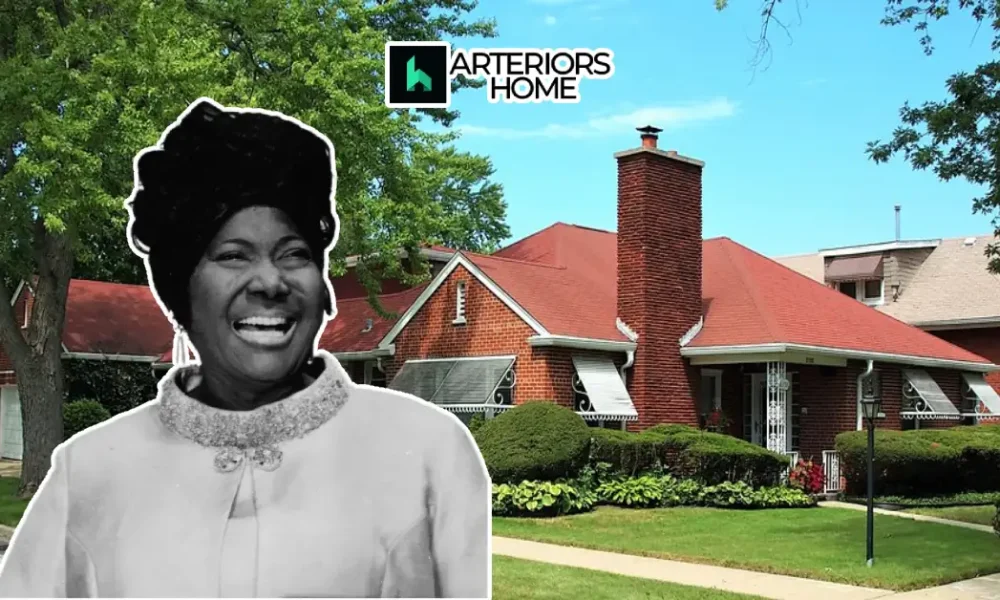The brick ranch house at 8358 South Indiana Avenue might not catch your eye at first glance. No velvet ropes, no tour buses, no gift shop hawking overpriced souvenirs. Yet this modest home in Chicago’s Chatham neighborhood holds more cultural significance than many flashier celebrity mansions. This is the Mahalia Jackson House, where the undisputed “Queen of Gospel” once lived and made history.
Unlike today’s celebrities who showcase their homes on Instagram or reality TV, Jackson’s residence tells a deeper story about breaking barriers, both musical and social.
Let’s step inside the world of a true American icon whose influence still reverberates through music today.
The Original Voice That Changed Everything
Before Beyoncé, before Whitney, before Aretha, there was Mahalia. Born in New Orleans in 1911, she grew up in extreme poverty in a three-room house shared with twelve others. Her mother died when she was just five, leaving her to be raised by her strict aunt, who forbade secular music.
That restriction shaped Jackson’s musical destiny. By focusing exclusively on the gospel, she developed a style that would transform American music forever. Her powerful contralto voice earned such respect that Dr. Martin Luther King Jr. claimed, “A voice like hers comes along once in a millennium”.
Jackson’s rise to fame wasn’t overnight:
- Moved to Chicago at 16 and joined the Greater Salem Baptist Church choir
- Toured with composer Thomas A. Dorsey for 14 years
- Recorded her breakthrough hit “Move On Up a Little Higher” in 1947, which sold an astonishing 2 million copies
- Became the first gospel artist to perform at Carnegie Hall in 1950
- Toured Europe as the first gospel recording artist to gain international acclaim
By the time of her death in 1972, Jackson had sold an estimated 22 million records and amassed a fortune worth approximately $4 million (equivalent to about $24 million today). Not bad for someone who refused to compromise her artistic integrity by crossing over to secular music.
The House That Gospel Built
In 1956, Jackson’s success allowed her to purchase the seven-room brick ranch at 8358 South Indiana Avenue for $40,000. But this wasn’t just another celebrity home acquisition – it was a bold statement in the fight for equal housing.
Breaking Color Barriers in Chicago Real Estate
When Jackson began house-hunting in Chatham, she encountered the harsh reality of Chicago’s segregated housing market. Real estate agents consistently told her homes with “For Sale” signs had suddenly been sold.
The breakthrough came when she met a white surgeon who had heard her sing and proudly sold his house to her. Jackson became just the second African-American homeowner on the block – a fact that didn’t sit well with some neighbors.
The backlash was swift and dangerous:
- Rifle bullets were fired through her windows
- Police protection was required for nearly a year
- Neighbors moved away in what became part of Chicago’s infamous “white flight.”
Jackson’s simple desire to own a nice home in a good neighborhood became an unwitting front line in the battle for civil rights, years before she would stand beside Martin Luther King Jr. at the March on Washington.
Inside the Gospel Queen’s Castle
Jackson transformed the house to reflect both her New Orleans heritage and her hard-won success. She purchased Louis XIV furniture ,common in wealthy Louisiana homes and built an addition to the back of the house. The most distinctive feature? A white wrought iron veranda in classic New Orleans style that still remains to this day.
The home became more than just a residence – it was a gathering place for:
- Civil rights leaders, including Martin Luther King Jr.
- Journalists like Edward Murrow and Studs Terkel
- Fellow musicians, including Louis Armstrong
- Jackson’s extended family of nieces and nephews
Jackson’s Broader Legacy
Jackson’s influence extended far beyond the walls of her Chicago home. Her unique vocal style – blending the freedom of gospel with elements borrowed from blues singers like Bessie Smith – created a sound that would shape generations of artists across multiple genres.
Her recording innovations, particularly her use of the “vamp” (an indefinitely repeated phrase that provides a foundation for improvisation), became a defining characteristic not just of gospel but also influenced the development of soul and rhythm and blues.
Jackson’s cultural impact was so profound that when she performed at the 1963 March on Washington, it was her powerful rendition of “I Been ‘Buked and I Been Scorned” that set the stage for King’s iconic “I Have a Dream” speech. In fact, during that speech, it was Jackson who called out to King, “Tell them about the dream, Martin!” – prompting him to abandon his prepared text and deliver his most famous words.
A Landmark With a Story to Tell
In 1970, Jackson moved from her Chatham home to Hyde Park, leaving the Indiana Avenue house empty for two years. The property was eventually sold to Roland Burris, a banker who had been helping Jackson with her finances. Burris later became Comptroller and Attorney General of Illinois and briefly served as a U.S. Senator.
Today, the house stands as a historical landmark with a Chicago Tribune marker in front that commemorates Jackson’s contributions to gospel music and American culture. While the marker tells visitors about Jackson’s achievements, local historians note it doesn’t fully capture the struggles she endured simply to live in the neighborhood she chose.
Building Wealth Beyond Music
Unlike many artists who focus solely on their craft, Jackson showed remarkable business acumen. Her estate value of $4 million at the time of her death (approximately $24 million in today’s currency) came from diverse sources:
- Recording career spanning about 30 albums and numerous million-selling singles
- Real estate investments throughout Chicago’s South Side
- A chain of restaurants called “Mahalia Jackson’s Chicken Dinners”
- A line of canned foods bearing her name
When landlords complained about her practicing singing at night, Jackson didn’t just find a new apartment – she bought her own apartment building. This entrepreneurial spirit made her a multimillionaire at a time when few African American women had access to such wealth-building opportunities.
Why Mahalia Jackson House Matters Today
In an era of McMansions and celebrity home tours, the Mahalia Jackson House represents something more meaningful. It stands as a physical reminder of how one extraordinary artist used her success to challenge systemic racism in housing, not through protest signs or boycotts, but simply by insisting on her right to live where she pleased.
For today’s celebrities and influencers who own multiple luxury properties, Jackson’s story offers a powerful lesson in how a single home purchase can represent something much greater than status or investment.
The preservation of her home ensures that future generations will understand the profound impact of this remarkable woman. Her estate’s value at the time of her death reflects not only her commercial success but the lasting value of her artistic and cultural contributions.
Recognition and Legacy That Lives On
Jackson’s impact continues to be celebrated decades after her death:
- Inducted into the Rock and Roll Hall of Fame in 1997 in the Early Influences category
- Member of the Gospel Music Hall of Fame and Hollywood Walk of Fame
- Honored with a commemorative U.S. Postal Service stamp
- The Mahalia Jackson Theater of Performing Arts in New Orleans serves as a permanent tribute
- Her birthplace in New Orleans has been preserved as part of the city’s musical heritage trail
The Bottom Line
The Mahalia Jackson House represents far more than just another celebrity home. It stands as a testament to one woman’s journey from poverty in New Orleans to international acclaim – and her willingness to face down racism and violence for the simple right to live where she chose.
In a world obsessed with celebrity real estate as status symbols, Jackson’s modest brick ranch with its New Orleans-style veranda reminds us that sometimes the most powerful statement is simply claiming your rightful place in the world – and refusing to back down when others try to deny it.
For pop culture enthusiasts and those interested in the intersection of celebrity, civil rights, and American music history, the Mahalia Jackson House offers a unique window into a time when buying a home could be both a personal triumph and a political act of courage.
What’s your take – should more historic celebrity homes be preserved as landmarks? Drop a comment below with your thoughts on the importance of maintaining these physical connections to our cultural past.
Explore more inspiring historic homes and their stories—subscribe to Arteriors Home for exclusive insights and design inspiration!




No Comment! Be the first one.